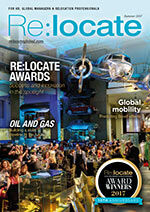Mobility in APAC: exploring current trends
Worldwide ERC held its 2017 Asia Pacific summits earlier this year. President and CEO Peggy Smith talked to Ruth Holmes about the impact of immigration changes, talent, and the future of mobility.

RH: What were the key themes at this year’s Worldwide ERC APAC summits?
PS: There were two major areas of keen interest at our APAC summits, which were held in Hong Kong, Singapore and Shanghai: the recently introduced China Unified Work Authorisation Policy and the theme of Chinese multinationals going global.Two of our summit presenters from Fragomen China – Becky Xia, partner, and Wendy Xie, director – reviewed China’s new Unified Work Authorisation Policy. This has a two-fold purpose: to attract foreign talent that supports the country’s growth as a knowledge and technology economy, and to limit the admission of general foreign workers to protect the local labour force.The policy was first piloted in key locations, including Beijing, Shenzhen and Guangzhou, and implemented nationwide on 1 April. Applicants from Hong Kong, Macau and Taiwan will not be affected.Classifications for foreign nationals include Category A, for top-talent foreign nationals; Category B, for professionals; and Category C, for general foreign workers who participate in seasonal or temporary work. Even a title or an occupation change can trigger additional requirements, and it is advisable for companies to review appropriate processing and lead times.The theme of Chinese multinationals going global raises the issue that Asian MNCs may need more customisation as they develop their mobility programmes. The hallmarks of best-in-class mobility in APAC are aligned with overall global mobility trends: having the right policies, employing the right staff, and collecting data to track the function’s performance and progress.While it was noted that certain initiatives – including addressing compliance, collaborating with service providers, encouraging and attracting employees to global assignments, and matching assignees with the right package – were areas of strength, some of the challenges that were indicated included cost reduction, developing alternative policy types, technology, and aligning mobility with talent strategy.Because the mobility industry took root in the West at the start, it has a Western perspective, even though it is maturing and broadening globally. Regional MNCs are finding that they need different, more Eastern-based products from the mobility industry.As their own mobility environment matures, there is a stronger desire to design and align mobility with in-country business processes, worker engagement, incentives, recruiting and retention, and company and corporate culture there. We will see that trend emerge more strongly as we move forward.RH: What are your thoughts on the future of work?
PS: There is much change afoot. The very nature of our workforce is shifting. One of our APAC summit presenters, Joe Logudic, Asia Pacific leader of global employer services at Deloitte Tax, noted that up to 53 per cent of today’s jobs would be gone in ten years.Deloitte believes that 11 million jobs will be lost in the UK alone by 2025. But we need to know that all of these jobs will not be wiped away; many of them will change as new skills are needed.Seventy per cent of employers believe they need a different mix of talent for the future. We’re already seeing a blend of traditional employees, project workers and gig workers, with projections increasing for more ‘on-demand’ workers even as the gig economy expands.Robotics, cognitive computing and artificial intelligence (AI) will bring even more change. In fact, companies are investigating the value that AI brings to HR functions and processes in areas like improving the employee experience, enhancing talent acquisition and on-boarding processes, and making the online learning experience richer and more effective.As technology takes on a bigger role in business, there will be an increase in jobs at the ‘human-like’ end of the spectrum, incorporating skills and abilities like listening, oral expression, interpreting feelings, coordination, managing time, and social perceptiveness. That’s good news for us humans!RH: What does this mean for global mobility?
PS: This year and the next few years have the potential to be ambitious and pivotal ones for global mobility. We are seeing immense changes to the way we get work done, the kinds of worker we employ, where they work, and how they are compensated.We’re witnessing more nationalistic tendencies from some of our world’s major economic regions. That limits some of the movement that we’ve been used to. Yet we also have more connectivity and more opportunities driving the world’s CEOs to plan their companies’ futures. And we have more knowledge than ever before to build the world’s workforce strategically and thoughtfully.For all of us, this is an exciting time to be mobility leaders.Read more about current issues facing global mobility professionals in the Summer issue of our magazine Get access to our free Global Mobility Toolkit
Get access to our free Global Mobility Toolkit  © 2017. This article first appeared in the Summer 2017 edition of Relocate magazine, published by Profile Locations, Spray Hill, Hastings Road, Lamberhurst, Kent TN3 8JB. All rights reserved. This publication (or any part thereof) may not be reproduced in any form without the prior written permission of Profile Locations. Profile Locations accepts no liability for the accuracy of the contents or any opinions expressed herein.
© 2017. This article first appeared in the Summer 2017 edition of Relocate magazine, published by Profile Locations, Spray Hill, Hastings Road, Lamberhurst, Kent TN3 8JB. All rights reserved. This publication (or any part thereof) may not be reproduced in any form without the prior written permission of Profile Locations. Profile Locations accepts no liability for the accuracy of the contents or any opinions expressed herein. 






































